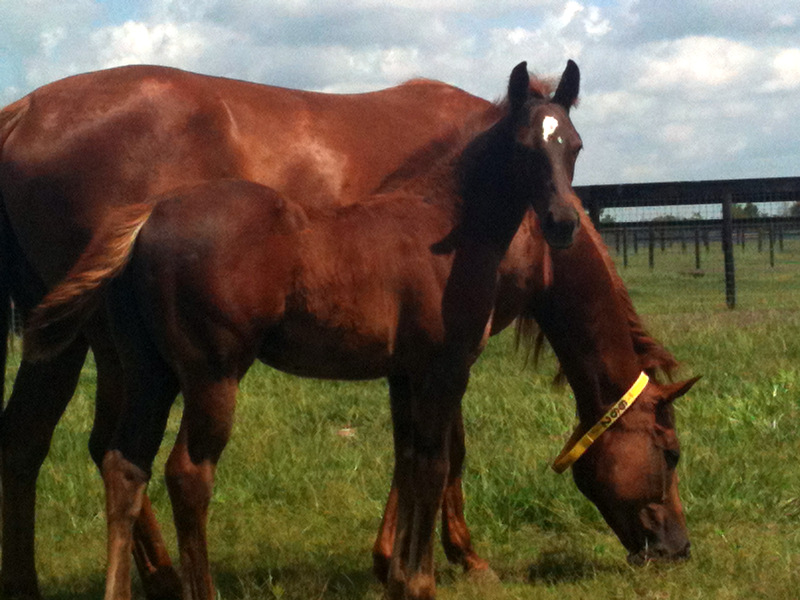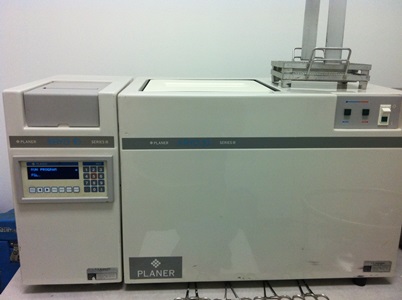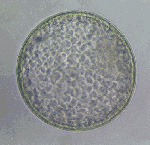 Whether a mare is maiden, recently foaled, or barren can influence her ability to conceive when breeding her with frozen semen. The first pregnancy obtained by using frozen-thawed semen in the equine species dates back to 1957 and was obtained using epididymal semen. However, for many years this reproductive technology has achieved limited progress in the horse compared with other species such as cattle. This was mainly because for a very long period of time only a few horse registries allowed the use of frozen-thawed semen. Hence, economic interests and resources allocated to research have always been minimal and as a result obstructing advances in this area.
Whether a mare is maiden, recently foaled, or barren can influence her ability to conceive when breeding her with frozen semen. The first pregnancy obtained by using frozen-thawed semen in the equine species dates back to 1957 and was obtained using epididymal semen. However, for many years this reproductive technology has achieved limited progress in the horse compared with other species such as cattle. This was mainly because for a very long period of time only a few horse registries allowed the use of frozen-thawed semen. Hence, economic interests and resources allocated to research have always been minimal and as a result obstructing advances in this area.
Today, almost all the horse registries allow the use of frozen semen which has encouraged researchers to focus on identifying better semen freezing techniques and to simplify artificial insemination protocols. This has resulted in an improvement in the fertility of frozen equine semen which has enhanced its use by breeders. In this article, Dr. Sandro Barbacini of SBS Italia discusses research performed on improved freezing techniques/insemination protocols, how maiden and barren mares can influence fertility when breeding with frozen semen as well as embryonic loss in barren mares.
Improved Freezing Techniques and Insemination Protocols
A few papers published in the European Union and the United States over the last few years clearly show that the development of improved techniques for freezing equine semen allow a greater percentage (85-90%) of stallions, than has traditionally been reported in the literature, to be capable of producing semen with commercial acceptable post-thaw quality. For more information please see our FAQ, “Do all stallions have semen that can be frozen?” However, success with frozen semen requires that the practitioner be familiar with the techniques of properly thawing, evaluating and handling of frozen semen as well as the breeding strategies employed to maximize fertility. For additional information on these subjects please see our FAQ, “Is it difficult to thaw and inseminate with frozen semen?”
Data published in the last 20 years clearly shows that excellent pregnancy rates can be obtained by using equine frozen-thawed semen in a commercial setting. The high fertility of cryopreserved stallion semen that is observed in the field may be attributed to the more sophisticated freezing methods (Not All Frozen Semen is Created Equally) and simpler insemination protocols (Timed Insemination Protocol) developed over the last few years.  However, it may also be because more practitioners are familiar with the techniques of properly thawing, evaluating and handling frozen semen. Nevertheless, the majority of the frozen semen fertility data was collected under field conditions and not from controlled studies.
However, it may also be because more practitioners are familiar with the techniques of properly thawing, evaluating and handling frozen semen. Nevertheless, the majority of the frozen semen fertility data was collected under field conditions and not from controlled studies.
Ideally, to determine more accurate fertility of equine frozen semen, experiments should be designed so that large numbers of mares are randomly assigned to be inseminated with frozen-thawed semen of different stallions and containing different numbers of progressively motile, morphologically normal spermatozoa (It Only Takes One…Right?). Data reported in the literature have reported per-cycle pregnancy rates ranging from 38% to 73% and seasonal pregnancy rates from 76% to 82%. Nevertheless, these results could have been strongly affected not only by the post-thaw semen quality and stallion selection but also from the mare management techniques and/or mare selection criteria.
There are many factors that can positively or negatively affect the pregnancy outcome of mares bred with cryopreserved stallion semen and one of the most important is the reproductive status of the mare. When speaking of their reproductive status, mares are defined in terms that have very specific applied meanings. The definition of mare status is:
- Maiden mare: A mare that is entering the breeding season for the first time and has never been inseminated with fresh, cooled or frozen semen or bred naturally
- Barren mare: A mare that did not conceive in the previous breeding season, often despite multiple breeding attempts.
- Foaling Mare: A mare that has foaled during the current breeding season in which she is to be bred.
Mare selection based on reproductive status influences the results obtained with frozen equine semen. Reports published in France, Italy and the USA demonstrate a higher fertility rate in foaling mares rather than in maiden or barren mares. However, when discussing the foaling mare, it is important to note that mares bred with frozen-thawed semen are usually not inseminated on their foal heat. For more information on this subject please see our article, Breeding Mares on Foal Heat.
Maiden Mares
 A field study published after collecting clinical data within our SBS International Network of Affiliate Laboratories, reported that maiden mares have a lower per cycle fertility (35%) than foaling (54%) or barren mares (53% ). Another study conducted in Italy showed a lower per season fertility rate for maiden mares (76%) versus foaling mares (88%). All the maiden mares taken into consideration by this study were Warmblood breeds. It is well known that Warmblood mares tend to perform in sporting events much longer than Thoroughbred, Standardbred or Quarter Horse mares. Therefore, there is a greater number of “old maidens” in this breed. Our article, How to Prepare the Older Mare for Breeding Season, describes how you can be prepared when breeding these mares.
A field study published after collecting clinical data within our SBS International Network of Affiliate Laboratories, reported that maiden mares have a lower per cycle fertility (35%) than foaling (54%) or barren mares (53% ). Another study conducted in Italy showed a lower per season fertility rate for maiden mares (76%) versus foaling mares (88%). All the maiden mares taken into consideration by this study were Warmblood breeds. It is well known that Warmblood mares tend to perform in sporting events much longer than Thoroughbred, Standardbred or Quarter Horse mares. Therefore, there is a greater number of “old maidens” in this breed. Our article, How to Prepare the Older Mare for Breeding Season, describes how you can be prepared when breeding these mares.
The decreased fertility of maiden mares observed in the above studies is similar to findings reported in a field trial conducted in Canada. In this study, it was reported that maiden mares over the age of 7 years had reduced fertility compared with younger maiden mares.
Barren Mares
There are many anecdotal reports within the horse breeding industry that suggest barren mares are poor candidates for artificial insemination with frozen-thawed semen. However, another study retrospectively analysed data collected on 285 barren mares inseminated in Northern Italy and reported an acceptable per-cycle (37%) and seasonal (71%) pregnancy rate when these mares were bred with frozen semen. Also, the authors obtained a significantly higher per-cycle pregnancy rate (52%) in barren mares inseminated with frozen semen that had post-insemination fluid accumulation and were treated with oxytocin and/or uterine lavage compared to barren mares with no post-insemination fluid and no treatment (29%).
Brazilian researchers showed that barren mares with a history of intense inflammatory uterine responses after insemination had significantly greater pregnancy rates when treated with corticosteroids before and at the time of insemination, compared to barren mares which weren’t treated. The authors of the above mentioned paper speculated that corticosteroid therapy can reduce the intense uterine reaction that happens in barren mares after insemination and can be an option to improve pregnancy rates in mares with poor breeding history.
Embryonic Loss in Barren Mares
It is well known that embryonic death is a substantial cause of economic loss in the horse breeding industry. The incidence of embryonic loss during the first 14-50 days of gestation has been reported to vary between 5 and 24% when using natural mating or fresh semen. A few years ago veterinarians working at SBS Italia collected data from 464 Warmblood mares that were inseminated with cryopreserved semen within 6 hours pre- and 6 hours post-ovulation. They found the overall conceptus loss rate of 8.9% between 14 and 50 days of  gestation.
gestation.
The authors also analyzed the data by subdividing the mares into reproductive and age groups. The barren mare group displayed greater embryo losses (14.6%) than the maiden (5.3%) and the foaling mares (7.8%). This is probably related to the fact that most of the sub-fertile mares were concentrated in this “barren mare” group.
Interestingly, a very recent study was conducted in a commercial artificial insemination center located in Northern England on a large number of mares (578) and cycles (1023) inseminated with fresh, cooled or frozen semen. This retrospective study analyzed fertility data between mares inseminated with different types of semen. All the mares included in this study were also divided by their reproductive status. They found per cycle pregnancy rates were significantly lower in barren mares inseminated with either cooled or frozen semen compared with barren mares inseminated with fresh semen. There was no difference between the mares bred with cooled semen and those bred with frozen semen.
Conclusion
The quality of the frozen semen does play a role on whether the mare obtains a pregnancy. However, the above research shows that the status of the mare, whether a maiden, barren or foaling mare, certainly plays a role as well. When deciding whether to breed a mare with frozen semen it is best to not only inquire about the quality and fertility of the semen but to also take into consideration the mare you will be breeding.
If you like this article you may be interested in:
The History of the Timed Insemination Protocol
Photo of jumping mare provided by Matty O'Rourke





